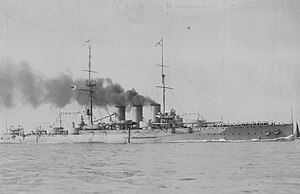
Back طراد مدرع Arabic Браняносны крэйсер Byelorussian Броненосен крайцер Bulgarian Creuer cuirassat Catalan Pancéřový křižník Czech Panserkrydser Danish Panzerkreuzer German Crucero acorazado Spanish Soomusristleja Estonian ناو زرهی Persian

The armored cruiser was a type of warship of the late 19th and early 20th centuries. It was designed like other types of cruisers to operate as a long-range, independent warship, capable of defeating any ship apart from a battleship and fast enough to outrun any battleship it encountered.
For many decades, naval technology had not advanced far enough for designers to produce a cruiser that combined an armored belt with the long-range and high speed required to fulfill its mission. For this reason, beginning in the 1880s and 1890s, many navies preferred to build protected cruisers, which only relied on a lightly armored deck to protect the vital parts of the ship. However, by the late 1880s, the development of modern rapid-fire breech-loading cannons and high-explosive shells made the reintroduction of side armor a necessity. The invention of face-hardened armor in the mid-1890s offered effective protection with less weight than previously.
Varying in size, the armored cruiser was distinguished from other types of cruiser by its belt armor—thick iron (or later steel) plating on much of the hull to protect the ship from shellfire much like that on battleships. The first armored cruiser, the Imperial Russian Navy's General-Admiral, was launched in 1873 and combined sail and steam propulsion. By the 1890s, cruisers had abandoned sail and took on a modern appearance.
In 1908, the armored cruiser was supplanted by the battlecruiser, which, with armament equivalent to that of a dreadnought battleship and speed equivalent to that of a cruiser, was faster and more powerful than an armored cruiser. At around the same time, the term "light cruiser" came into use for small cruisers with armored belts. Although they were now considered second-rate ships, armored cruisers were widely used in World War I. Most surviving armored cruisers from this conflict were scrapped under the terms of the Washington Naval Treaty of 1922, which imposed limits on warships and defined a cruiser as a ship of 10,000 tons or less carrying guns of 8-inch caliber or less—rather smaller than many of the large armored cruisers. A handful survived in one form or another until World War II. Only one, the Greek Navy's Georgios Averof, has survived to the modern day as a museum ship.
© MMXXIII Rich X Search. We shall prevail. All rights reserved. Rich X Search